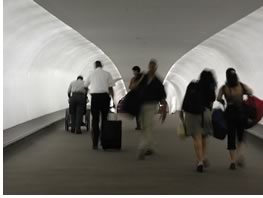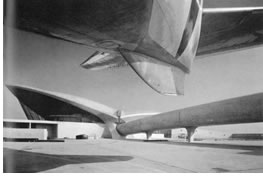

Managing Editor
You never forget your first building-the one that made you know, in your heart of hearts, the ineffable power of architecture to evoke emotion through space. For many, it's a cathedral; for others, a skyscraper. For me, it was an airline terminal.
 I
first saw Eero Saarinen's TWA terminal at Idlewild (now JFK) Airport in
Queens, N.Y., about a year after its 1962 opening. I was 9, stuffed with
self-importance of going to the airport to see my grandmother off to Florida.
I walked-skipped-jumped onto the TWA-red carpets and into a world of glass-enclosed
space that rooted me to the spot. I almost lost the rest of my clan as
they traveled down the long connector tube, caught up in awe of the giant
curves of concrete and wide expanses of walkway. I knew
it epitomized flight, and I knew with certainty that the building was
the cause of my uplifted spirits. That was the defining moment—I
was hooked.
I
first saw Eero Saarinen's TWA terminal at Idlewild (now JFK) Airport in
Queens, N.Y., about a year after its 1962 opening. I was 9, stuffed with
self-importance of going to the airport to see my grandmother off to Florida.
I walked-skipped-jumped onto the TWA-red carpets and into a world of glass-enclosed
space that rooted me to the spot. I almost lost the rest of my clan as
they traveled down the long connector tube, caught up in awe of the giant
curves of concrete and wide expanses of walkway. I knew
it epitomized flight, and I knew with certainty that the building was
the cause of my uplifted spirits. That was the defining moment—I
was hooked.
 Saarinen's
TWA Terminal—the great, swooping concrete bird—captured the
essence of flight poised on the threshold of the Jet Age. It is fitting
that all efforts be made to preserve its beauty for us, and for future
generations. However, it is apparent that the building just cannot function
as an airline terminal anymore. There was no way that Saarinen could have
anticipated the increase in the size of jets (the building was designed
to accommodate 707s) and the attendant runway space they demand, the sheer
number of passengers today, or the sad but necessary accoutrements and
procedures now required for security. Also, beautiful design it is; accessible
design, it is not. In the words of Port Authority Assistant Director for
Capital Programs Ted Kleiner, AIA, if you think like an airline passenger
instead of an architect, you probably would not want to travel through
the TWA Terminal today.
Saarinen's
TWA Terminal—the great, swooping concrete bird—captured the
essence of flight poised on the threshold of the Jet Age. It is fitting
that all efforts be made to preserve its beauty for us, and for future
generations. However, it is apparent that the building just cannot function
as an airline terminal anymore. There was no way that Saarinen could have
anticipated the increase in the size of jets (the building was designed
to accommodate 707s) and the attendant runway space they demand, the sheer
number of passengers today, or the sad but necessary accoutrements and
procedures now required for security. Also, beautiful design it is; accessible
design, it is not. In the words of Port Authority Assistant Director for
Capital Programs Ted Kleiner, AIA, if you think like an airline passenger
instead of an architect, you probably would not want to travel through
the TWA Terminal today.
In fact, view of the wonderful TWA Terminal of yore (and "yore" was a scant 40 years ago) exists only in our minds, and in magnificent photos such as Ezra Stoller's unforgettable series. In an effort to keep pace with the breakneck speed with which air travel has evolved, the building has been added to, backed up against, blocked, and stop-gap painted—to the point where its views and forms are obscured. Its owner, teetering on the edge of solvency for years, has just been bought up by American Airlines. And, the crowded and absolutely essential JFK Airport is in the midst of a $10 billion modernization plan that simply cannot support an obsolete terminal as one of its 10 terminal sites. This is the TWA
Terminal's moment
of truth.
Thankfully, the TWA Terminal is in the capable hands of the Port Authority
of New York and New Jersey, which is making every effort to save the terminal
and incorporate it—albeit with a new use—as the architectural
flagship of the modernized international airport. The Port Authority,
the arbiter of the building's fate, has made extensive good-faith efforts
to work with preservation groups (the building was designated as a city
landmark in 1994).

The agency has modified its original plan extensively to save the jetways originally designed to connect the terminal to its two boarding pods. The revised plan includes sinking the arrivals roadway so that these umbilical jetways can be preserved and connected to the new terminal, as well as keeping the profile of the new terminal as low as functionally possible to give the Saarinen building its architectural due. The existing accretions will be stripped away, and Saarinen's original landscape and design intent will be restored.
But, you can't have everything. The boarding pods—one of which is part of the city landmark status; the other, added to the building later—have to go to make room for the new terminal. A new use and new owner/caretaker need to be found for the Saarinen terminal. Suggestions range from a restaurant to a conference center to a museum or gallery. Considering the new plans and upgrades for the airport and its new region-connecting train system, it's not hard to imagine it being successful at any of these activities.
 As
is their rightful function, preservationists remind us that we must be
eternally vigilant in guarding our architectural treasures. In this case,
they fear that the building will not find a new owner, become more dilapidated,
and be torn down. These fears are not totally unfounded, and should keep
us vigilant. However, the Port Authority—by reason of its current
plan—shows no inclination to allow this to happen; in fact, quite
the opposite. It is the Port Authority's rightful function to preserve
a magnificent, one-of-a-kind building the best they can and provide safe
and efficient transportation to the denizens of the New York metro region
and its visitors. And it seems as though the agency's architects have
created a proper balance.
As
is their rightful function, preservationists remind us that we must be
eternally vigilant in guarding our architectural treasures. In this case,
they fear that the building will not find a new owner, become more dilapidated,
and be torn down. These fears are not totally unfounded, and should keep
us vigilant. However, the Port Authority—by reason of its current
plan—shows no inclination to allow this to happen; in fact, quite
the opposite. It is the Port Authority's rightful function to preserve
a magnificent, one-of-a-kind building the best they can and provide safe
and efficient transportation to the denizens of the New York metro region
and its visitors. And it seems as though the agency's architects have
created a proper balance.
Copyright 2001 The American Institute of Architects. All rights reserved.
![]()
|
Saarinen's Beloved TWA Terminal and Air Travel for the Future: Can This Marriage Be Saved? Full Story DOCOMOMO Helps Safeguard Saarinen's TWA Terminal Full Story Photos courtesy of the Port Authority of New York and New Jersey. |
|